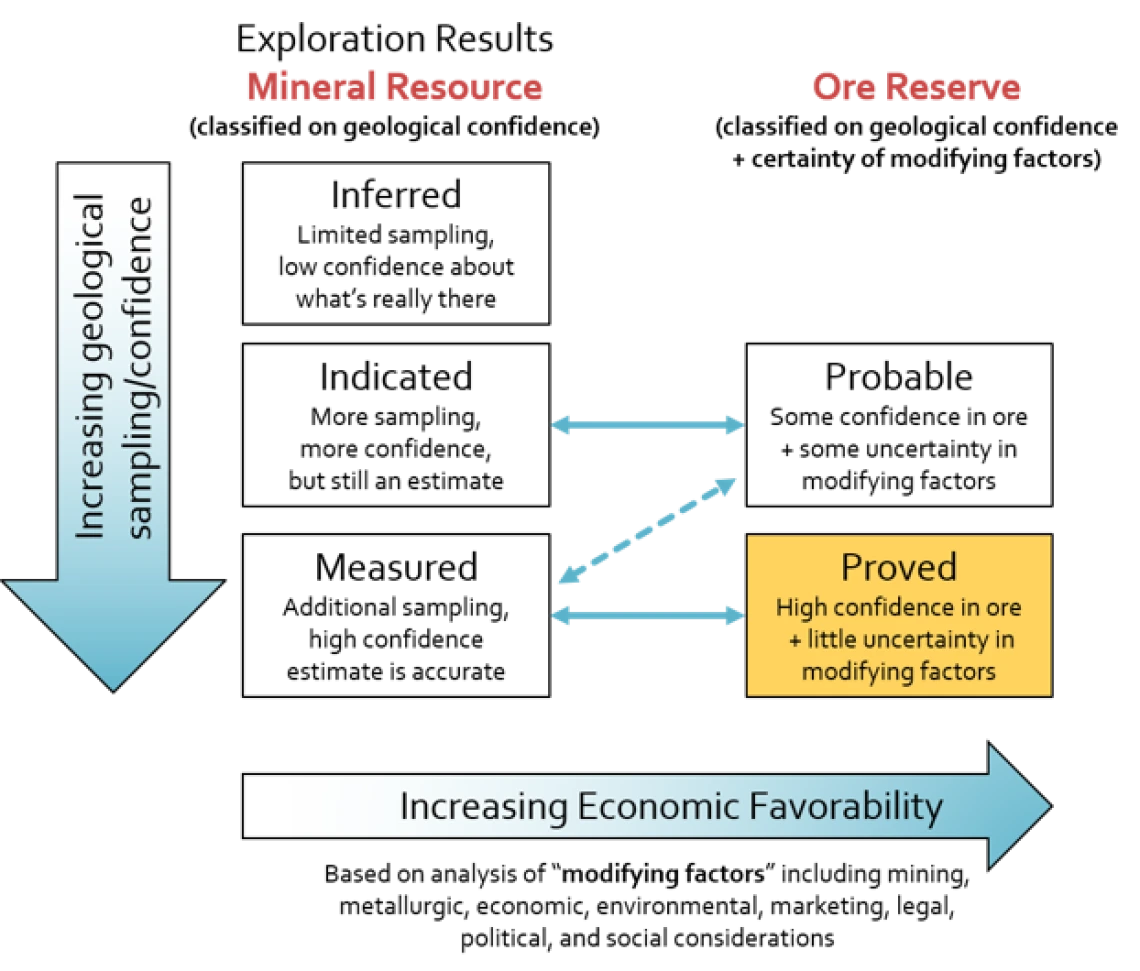
The Life Cycle of a Mine
The stages in the life cycle of a mine are:
- Prospecting and Exploration
- Development
- Extraction
- Closure/Reclamation
Each of the stages may overlap with the next and is very lengthy and expensive.
1. Prospecting and Exploration (“Finding and Defining it”)
Prospecting and exploration are precursors to mining and often occur simultaneously; together, they can take two to eight years to complete, and may cost from $500,000 to $15 million overall.
Prospecting is the process of searching the region for mineral deposits. Historically, prospectors would explore a region on foot with a pick and shovel. Modern prospecting uses a variety of geological methods. Geology experts use a direct method to discover surface mineral deposits by examining the area visually. Geophysics experts use an indirect method to identify underground mineral deposits by detecting rock alterations under the surface. Geochemistry can also be used to analyze samples of soil, rock, and water. These methods are supplemented by aerial or satellite photography, and combined with historical maps and literature to develop detailed maps of surface and underground rock formations. Drilling is used to search for mineral occurrences or the clues in the rocks that may lead to them. Information gathered in this stage may or may not lead to a discovery of valuable minerals.
In mining exploration, experts use additional techniques to determine the possible size and value of the mineral deposit discovered during prospecting. Depending on the ownership of the land, a Mineral Rights Lease, a contractual arrangement that allows the holder to explore/exploit an area that contains minerals, may be required. Samples that are collected by drilling undergo various analyses by geologists and metallurgists to determine the richness and extent of the mineral, both vertically and horizontally. Such analyses of geological confidence and technical and economic evaluation allow experts to label the deposit as a “mineral resource” and/or an “ore reserve,” to better establish the economic value of the deposit and to estimate mining costs (JORC, 2012).
General relationship between Mineral Resources and Ore Reserves. Adapted from: Australasian Code for Reporting of Exploration Results, Mineral Resources and Ore Reserves (JORC, 2012).

General relationship between Mineral Resources and Ore Reserves. Adapted from: Australasian Code for Reporting of Exploration Results, Mineral Resources and Ore Reserves (JORC, 2012).
A mineral resource is a concentration of potentially valuable material that naturally occurs in the earth that can potentially be mined for economic profit. Whether it is worth extracting now or later may depend on the amount, form, location, and quality of the material, a concept called geological confidence. Experts use geological sampling and testing methods to classify a mineral resource into three different categories according to geological confidence. When the amount and quality of the mineral can be estimated with only a low level of confidence based on limited sampling, it is called an “inferred” mineral resource. Such a resource will likely not be mined at this time, but may be mined one day in the future, either because all other reserves have been exploited or because improvements in technology make it easier to extract less concentrated ores. Additional sampling may allow the amount, quality, density, shape, and physical characteristics of the mineral to be estimated with a reasonable level of confidence, and it is classified as an “indicated” mineral resource. If further sampling and reliable and detailed exploration allow the amount, quality, density, shape, and physical characteristics of the mineral to be accurately estimated with a high level of confidence, it is classified as a “measured” mineral resource.
An ore reserve is the part of the mineral resource that can be economically profitable to mine (i.e., there is enough valuable metal to be worth removing it and extracting it from all of the surrounding rock). After a deposit has been identified as an inferred, indicated, or measured mineral resource, it is next labeled as a “probable” or “proved” ore reserve. This classification is based on what is known about the mineral resource through sampling, combined with consideration of “modifying factors,” such as mining, metallurgic, economic, environmental, marketing, legal, political, and social factors. With some information available about the concentration of the ore (i.e., indicated mineral resource), and some uncertainty in the modifying factors, the deposit can be labelled a probable ore reserve. A mine developed from a probable ore reserve has a chance of success, but is still financially risky. A measured mineral resource may also be labelled as only a possible ore reserve, if there is uncertainty in the consideration of the modifying factors; if these uncertainties can be removed, it may later be labelled a proved ore reserve. When the concentration of ore has been accurately and confidently measured to be high (i.e. measured mineral resource), and there is limited uncertainty about the modifying factors, it is classified as a proved ore reserve. This is the highest confidence category of reserve estimate, implying high geological, technical, and economic confidence that it can be mined at a profit.
Following the completion of the prospecting and exploration stages, a feasibility study is performed to formally determine whether it is economically worth developing the mineral deposit into a mine. A feasibility report is generated, in which factors such as production rate, operating costs, income tax, and the sale price of the mineral are estimated as well as put into a formula to calculate what the final rate of return will be. The mining organization can then make a decision about whether the project will be abandoned or continued at this stage.
2. Development (“Planning and building it”)
The development stage usually takes 4-12 years to open an ore deposit for production, and may cost anywhere from $1 million to over $1 billion to complete depending on the type of mine. Development involves extensive pre-development planning and paperwork. Budget and financial reports are prepared and permits are requested. Reports regarding potential impacts on the environment and nearby communities are generated. Plans are assessed regarding the: 1) the mining process/technology that will be used, 2) building of access roads for transportation, 3) identification of resources such as power and water sources, and 4) construction of ore processing facilities and disposal areas for waste. At this point, tens of millions to hundreds of millions of dollars may have been invested in the project, but it may fail to open if the pre-development requirements are not met, including acceptance by the community. At this stage, just enough development of the mine site is performed to ensure that it will be able to be productive for the life of the mine, without later interruption.
Plans are made for the appropriate type of mining that will be performed. There are three major types of mining, surface mining, underground mining, and solution mining; their use depends on the type of ore and where it is located, as well as issues of safety, technology, economics, and environmental impacts. Surface mining, which includes strip mining, open-pit mining, and mountaintop removal, removes soil and rock from on top of the mineral deposit. It may begin as soon as the pre-development steps are complete. Underground mining uses shafts and tunnels to access deeply-buried mineral deposits, while the overlying rock is left in place. This type of mining is usually more expensive and complex, and requires a lot of additional planning for convenience and safety. Solution mining, sometimes referred to as in situ leaching, is performed by pumping a leaching solution such as an acid into the ground, where the solution then dissolves the solid minerals into a liquid. This liquid containing the minerals is then pumped out of the ground and the mineral can then be recovered by various techniques.
3. Extraction (“Mining it”)
In the extraction stage the mineral is removed from the earth in large quantities as the mine begins producing. This stage is typically what we envision when we think of mining. Some exploration and development may continue at this stage, as well. The extraction stage can take from 5-30 years to complete, although many mines have been open for more than 100 years, and may cost anywhere from a few million dollars to hundreds of millions of dollars a year depending on the size of the mine and its location.
4. Closure/Reclamation (“Cleaning it up”)
The mining organization begins planning for mine closure and reclamation early on; even before a mine is allowed to open, a reclamation plan must be set in place for its closure. In these reclamation plans the mining operator describes the processes it will use to attempt to restore or redevelop the land that has been mined to a more natural or economically usable state. This can include removing buildings and roads as well as covering up and re-vegetating rock piles. Federal and state regulations require mining companies to post funding for closure before the mining project begins. This is to ensure that reclamation is completed at the end of the mining closure (Arms, 2004). Once the mine has been depleted or is no longer economically feasible to continue mining, the mining operators must contact local and state agencies to close the mine, and must comply with their respective regulations.
The closure plan must be approved by a variety of mining stakeholders, including government and community members. Considerations when planning for closure include: protecting public health and safety, addressing environmental damage, returning the land to its original state or an acceptable new use, and sustaining social and economic benefits brought by the mine. The succeeding custodian, the party responsible for the land after the mine closes, should establish an agreement with the mining company early in the life cycle of the mine, to develop a closure plan that minimizes risks and liabilities.
The cost of closing a mine depends on the age, location, type, and size of mine, amount of waste, geological characteristics, and type of mineral being extracted. For example, a medium-sized open-pit mine that is 10-15 years old could cost a few million dollars to close, while a large open-pit mine that has been operating for more than 35 years could cost tens of millions of dollars to close (Tetra Tech, 2007). It is often less expensive for a mining company operating the mine to close a mine themselves than for the succeeding custodian to close it. For more detail on reclamation, refer to the “Mine Tailings and Waste Rock Reclamation” module.

